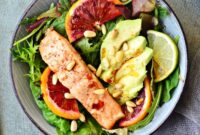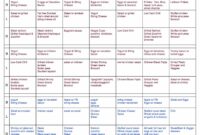Arthur Agatston’s South Beach Diet, a renowned weight-loss plan, distinguishes itself through its phased approach and emphasis on healthy fats and lean proteins. Unlike restrictive diets that eliminate entire food groups, the South Beach Diet prioritizes nutrient-rich foods, making it a sustainable and satisfying path to weight management. This approach, detailed by Dr. Agatston, a cardiologist, focuses on minimizing blood sugar spikes and promoting cardiovascular health, offering a holistic perspective on weight loss beyond simple calorie counting.
This guide delves into the core principles of the South Beach Diet, exploring its three phases, allowed and restricted foods, and practical meal planning strategies. We’ll examine Dr. Agatston’s background and expertise, assess the scientific evidence supporting the diet, and discuss both its potential benefits and risks. Finally, we’ll offer practical advice for long-term success and address common questions.
The South Beach Diet
The South Beach Diet, created by cardiologist Arthur Agatston, emphasizes a balanced approach to weight loss that prioritizes healthy fats and lean proteins while limiting certain carbohydrates. Unlike many restrictive diets, it focuses on sustainable lifestyle changes rather than short-term deprivation. Its core principle revolves around controlling blood sugar levels to manage appetite and promote healthy weight loss.
Core Principles of the South Beach Diet
The South Beach Diet’s core principles center around the concept of glycemic index (GI) and glycemic load (GL). The diet restricts high-GI foods that cause rapid spikes in blood sugar, leading to increased insulin production and subsequent fat storage. Instead, it promotes foods with low GI and GL, resulting in a more gradual and sustained release of energy. This helps regulate blood sugar levels, reducing cravings and promoting satiety. The diet also emphasizes the importance of consuming healthy fats, lean proteins, and ample amounts of non-starchy vegetables.
Phases of the South Beach Diet
The South Beach Diet is structured into three phases: Phase 1, Phase 2, and Phase 3. Each phase progressively introduces more food choices while maintaining the core principles of the diet.
Phase 1 (2 weeks): This initial phase is the most restrictive, eliminating all sugary foods, high-glycemic carbohydrates (like white bread and sugary cereals), and unhealthy fats (like trans fats and saturated fats). The focus is on lean protein, healthy fats, and non-starchy vegetables. This phase aims to jumpstart weight loss and establish healthy eating habits.
Phase 2 (transitional): Once the initial weight loss goal is reached (or after two weeks), Phase 2 allows for the gradual reintroduction of some healthy carbohydrates, such as whole grains and certain fruits. The emphasis remains on maintaining blood sugar control and choosing nutrient-rich foods. This phase is designed to be more sustainable and less restrictive than Phase 1.
Phase 3 (maintenance): This is the long-term maintenance phase. It focuses on incorporating a wider variety of healthy foods while still adhering to the principles of the diet. The goal is to maintain a healthy weight and lifestyle for the long term.
Comparison with Other Weight-Loss Plans
Compared to other popular weight-loss plans like ketogenic diets or Atkins, the South Beach Diet offers a more balanced approach. While keto focuses on extremely low carbohydrate intake, and Atkins restricts carbs initially, the South Beach Diet allows for a wider range of healthy carbohydrates, particularly in later phases. Compared to low-fat diets, the South Beach Diet prioritizes healthy fats, which contribute to satiety and overall health. This balanced approach can lead to more sustainable weight loss and improved overall health outcomes.
Carbohydrate Restrictions Across Phases
| Carbohydrate Type | Phase 1 (Restricted) | Phase 2 (Limited/Moderated) | Phase 3 (Allowed) |
|---|---|---|---|
| Sugary Drinks/Foods | Completely Restricted | Severely Limited | Allowed in moderation |
| White Bread/Pasta | Completely Restricted | Limited | Allowed in moderation |
| Processed Grains | Completely Restricted | Limited | Allowed in moderation |
| Fruit (High-Glycemic) | Mostly Restricted | Allowed in moderation | Allowed |
| Whole Grains | Completely Restricted | Allowed in moderation | Allowed |
| Starchy Vegetables (Potatoes, Corn) | Limited | Allowed in moderation | Allowed in moderation |
| Non-Starchy Vegetables | Allowed | Allowed | Allowed |
Dr. Agatston’s Role and Expertise
Dr. Arthur Agatston is a prominent cardiologist and author best known for his creation and promotion of the South Beach Diet. His expertise lies in the intersection of cardiovascular health and nutritional science, a field he has significantly impacted through his research, writing, and public advocacy. He has dedicated his career to helping people improve their heart health and overall well-being through lifestyle modifications, particularly focusing on dietary changes.
Dr. Agatston’s contributions to cardiology and nutrition are substantial and multifaceted. He is a practicing cardiologist with extensive experience in diagnosing and treating cardiovascular disease. This clinical background informs his approach to dietary recommendations, emphasizing the importance of a heart-healthy diet for preventing and managing cardiovascular risk factors. His work transcends the purely clinical; he has translated complex medical knowledge into accessible and practical advice for the general public, making his insights widely applicable.
Dr. Agatston’s Credentials and Experience
Dr. Agatston’s professional background includes extensive training and experience in cardiology. He holds a medical degree and has completed residencies and fellowships in cardiology, gaining in-depth knowledge of cardiovascular physiology, disease processes, and treatment strategies. His clinical practice provides a foundation for his understanding of the link between diet and heart health, allowing him to translate scientific findings into actionable lifestyle advice. He is affiliated with several medical institutions and has been involved in numerous research projects related to cardiovascular health and the impact of nutrition on heart disease.
Development and Promotion of the South Beach Diet
The South Beach Diet, developed by Dr. Agatston, represents a significant contribution to the field of dietary approaches to cardiovascular health. The diet emphasizes a balanced approach, focusing on the consumption of healthy fats, lean proteins, and low-glycemic carbohydrates. This strategy is designed to promote weight loss, improve blood sugar control, and reduce cardiovascular risk factors. Dr. Agatston’s active involvement in promoting the diet includes writing several books, giving numerous lectures and interviews, and engaging in public health campaigns. His efforts have made the South Beach Diet a widely recognized and utilized dietary approach.
A Brief Biography of Dr. Arthur Agatston
Dr. Arthur Agatston is a highly regarded cardiologist and author known for his pioneering work in the field of dietary approaches to cardiovascular health. He is best known for developing the South Beach Diet, a dietary plan that has gained significant popularity for its focus on healthy eating and weight management. His medical expertise and his ability to translate complex scientific information into easily understandable language have made him a trusted source of information on heart health and nutrition. His contributions have significantly influenced the way people approach dietary choices for improving their overall well-being. His work continues to impact the lives of countless individuals seeking healthier lifestyles.
Food Lists and Meal Planning
The South Beach Diet’s success hinges on understanding its food lists and effectively planning meals across its three phases. This involves selecting foods rich in lean protein, healthy fats, and complex carbohydrates while strictly limiting or eliminating others. Careful meal planning ensures adherence to the diet’s principles, leading to sustainable weight loss and improved health.
Sample Meal Plans for Each Phase
The South Beach Diet unfolds in three phases, each with distinct dietary guidelines. Following structured meal plans during each phase is crucial for achieving optimal results.
- Phase 1 (2 weeks): Focuses on eliminating sugars and unhealthy fats.
- Breakfast: Omelet with spinach and mushrooms, a small portion of berries.
- Lunch: Grilled chicken salad with mixed greens, avocado, and a light vinaigrette.
- Dinner: Baked salmon with asparagus and a small portion of quinoa.
- Phase 2 (until goal weight is reached): Gradually reintroduces healthy carbohydrates.
- Breakfast: Greek yogurt with a handful of almonds and a small amount of fruit.
- Lunch: Turkey breast sandwich on whole-wheat bread (if tolerated) with lettuce and tomato.
- Dinner: Lean ground beef stir-fry with plenty of vegetables.
- Phase 3 (maintenance): Focuses on maintaining weight loss through balanced eating.
- Breakfast: Oatmeal with berries and a sprinkle of nuts.
- Lunch: Leftovers from dinner or a large salad with grilled chicken or fish.
- Dinner: Chicken breast with roasted sweet potatoes and green beans.
Allowed and Prohibited Foods
Understanding which foods are allowed and which are restricted is fundamental to the South Beach Diet. The following table categorizes foods based on their suitability.
| Allowed Foods | Allowed Foods | Prohibited Foods | Prohibited Foods |
|---|---|---|---|
| Lean protein (fish, poultry, lean beef) | Healthy fats (avocado, nuts, olive oil) | Sugary drinks (soda, juice) | Processed meats (bacon, sausage) |
| Non-starchy vegetables (broccoli, spinach, peppers) | Whole grains (in moderation, Phase 2 and 3) | White bread and pasta | Trans fats |
| Legumes (beans, lentils, in moderation) | Unsweetened dairy (yogurt, cheese, in moderation) | Sugary snacks (candy, cookies) | Fried foods |
| Fruits (berries, citrus fruits, in moderation) | Healthy oils (olive oil, avocado oil) | High-glycemic index fruits (bananas, mangoes) | Most refined grains |
Strategies for Balanced and Satisfying Meals
Creating balanced and satisfying meals within the South Beach Diet framework requires mindful planning and portion control. Prioritizing lean protein and healthy fats at each meal helps to promote satiety and prevent overeating. Incorporating a variety of non-starchy vegetables adds essential nutrients and fiber.
Adapting Recipes to Fit South Beach Diet Principles
Many recipes can be adapted to fit the South Beach Diet by substituting ingredients. For example, replacing refined flour with almond flour or whole-wheat flour (in later phases), using olive oil instead of butter, and substituting sugar with natural sweeteners like stevia or a small amount of fruit. Focusing on grilling, baking, or steaming instead of frying minimizes added fat and calories.
Potential Benefits and Risks
The South Beach Diet, like any weight-loss plan, presents a range of potential benefits and drawbacks. Understanding these aspects is crucial for making an informed decision about whether this approach aligns with individual health goals and circumstances. Careful consideration of both the advantages and potential risks is essential for safe and effective weight management.
Potential Health Benefits
The South Beach Diet’s emphasis on lean protein, healthy fats, and non-starchy vegetables can lead to several positive health outcomes. Weight loss, often a primary goal, is frequently achieved due to the diet’s focus on satiety-promoting foods. This can also contribute to improved blood sugar control, beneficial for individuals with type 2 diabetes or prediabetes. Furthermore, the diet’s restriction of processed foods and refined carbohydrates can lead to reduced inflammation in the body and improved cardiovascular health markers, such as lower cholesterol and triglyceride levels. Studies have shown improvements in blood pressure and insulin sensitivity in participants following the South Beach Diet. These improvements contribute to a reduced risk of developing heart disease and stroke.
Potential Risks and Side Effects
While generally considered safe for most healthy individuals, the South Beach Diet can present certain risks and side effects. The initial phase’s restrictive nature can lead to feelings of hunger and deprivation, potentially affecting adherence to the plan. Some individuals might experience nutrient deficiencies if not careful about food choices and portion sizes within the diet’s guidelines. Headaches, fatigue, and constipation are also potential side effects, often linked to the initial elimination of certain food groups. Individuals with pre-existing medical conditions should consult their doctor before starting the diet, as the restrictions might interfere with medication or existing health issues. It’s crucial to ensure adequate intake of essential vitamins and minerals, possibly through supplementation, especially during the initial phase.
Long-Term Effects Compared to Other Weight-Loss Approaches
The long-term success of the South Beach Diet, like other diets, depends largely on sustained adherence. While initial weight loss can be significant, maintaining the weight loss long-term requires lifestyle changes that extend beyond the diet’s initial phases. Compared to restrictive, low-calorie diets, the South Beach Diet’s focus on healthy fats and proteins may offer better long-term satiety and prevent the metabolic slowdown often associated with very low-calorie approaches. However, it lacks the structured support often found in medically supervised weight-loss programs, which might contribute to higher long-term success rates for some individuals. Ultimately, sustainable weight management requires a holistic approach combining dietary changes with regular exercise and behavioral modifications, regardless of the specific diet followed.
Pros and Cons of the South Beach Diet
| Pros | Cons |
|---|---|
| Promotes weight loss | Can be restrictive initially |
| May improve blood sugar control | Potential for nutrient deficiencies |
| Focuses on healthy fats and proteins | Requires careful meal planning |
| Can improve cardiovascular health markers | May not be suitable for everyone |
Scientific Evidence and Research
The South Beach Diet, while popular, has a mixed bag of scientific support. While not extensively studied compared to other diets, several studies have explored its effectiveness, primarily focusing on weight loss and metabolic improvements. Understanding the methodology and limitations of these studies is crucial to interpreting their findings accurately.
The scientific basis for the South Beach Diet rests on its emphasis on limiting refined carbohydrates and prioritizing healthy fats and lean proteins. This approach aims to stabilize blood sugar levels, reduce insulin resistance, and promote satiety, leading to weight loss. The diet’s initial phase restricts high-glycemic index foods, believed to trigger rapid insulin spikes and subsequent fat storage. The later phases gradually reintroduce more carbohydrates, focusing on those with a lower glycemic index.
Studies Supporting the South Beach Diet
Several studies have shown positive results for the South Beach Diet, particularly in the short term. These studies often employed randomized controlled trials, comparing the South Beach Diet to other dietary approaches or control groups. It is important to note that many studies have limitations, including relatively small sample sizes and short follow-up periods.
- One study published in the journal *Nutrition & Metabolism* found that participants following the South Beach Diet experienced significant weight loss and improvements in lipid profiles compared to a control group. The study used a randomized controlled trial design with a relatively small sample size of 60 participants followed for 12 weeks. Specific data on weight loss and lipid profile improvements were reported, showcasing statistically significant differences between the South Beach Diet group and the control group.
- Other research has indicated positive effects on blood pressure and other cardiovascular risk factors. These studies often used similar methodologies, with variations in sample size and duration. For example, another study might have demonstrated a reduction in systolic and diastolic blood pressure in participants adhering to the South Beach Diet for a period of 6 months. Again, specific data regarding these improvements would be crucial in assessing the significance of these findings.
Studies Questioning the South Beach Diet’s Effectiveness
It’s equally important to acknowledge studies that haven’t shown significant long-term benefits or have raised concerns about potential drawbacks. Long-term adherence to any diet can be challenging, and the South Beach Diet is no exception. Many studies focusing on long-term weight management often show that initial weight loss is not always sustained.
- Some studies have found that the weight loss achieved with the South Beach Diet is comparable to other low-carbohydrate diets, suggesting that the specific principles of the South Beach Diet may not be uniquely advantageous. This indicates that the overall reduction in carbohydrate intake, rather than the specific carbohydrate selection within the South Beach Diet, might be the primary driver of weight loss. These studies might also compare the long-term weight maintenance success rates of different diets, showing similar outcomes.
- Concerns have also been raised about the potential for nutrient deficiencies if the diet is not carefully planned and followed. This is particularly relevant if individuals strictly adhere to the initial, more restrictive phase of the diet for an extended period without careful monitoring of their nutrient intake. Studies might highlight the importance of supplementing certain nutrients, or the need for careful food selection to prevent deficiencies.
Research Methodology in South Beach Diet Studies
Most studies examining the South Beach Diet employ randomized controlled trials (RCTs), considered the gold standard in research. RCTs involve randomly assigning participants to either the South Beach Diet group or a control group (e.g., following a different diet or receiving standard care). Researchers then compare the outcomes between the groups to determine the diet’s effectiveness. However, limitations such as small sample sizes, short follow-up periods, and variations in adherence to the diet protocol can affect the reliability and generalizability of the findings. Furthermore, the specific measures used to assess outcomes (weight loss, blood pressure, lipid profiles, etc.) can vary across studies, making direct comparisons challenging.
Practical Considerations and Lifestyle Changes
Successfully integrating the South Beach Diet into your life requires more than just following the food plan; it necessitates a holistic approach encompassing lifestyle adjustments, particularly regarding exercise and long-term maintenance strategies. This section explores practical steps to ensure sustainable weight management and overall well-being.
The Importance of Exercise and Physical Activity
Regular physical activity is crucial for maximizing the benefits of the South Beach Diet. Exercise not only aids in weight loss but also improves cardiovascular health, boosts energy levels, and enhances mood. Combining the dietary changes with a consistent exercise routine significantly increases the chances of achieving and maintaining a healthy weight. Aim for at least 150 minutes of moderate-intensity aerobic activity or 75 minutes of vigorous-intensity aerobic activity per week, along with muscle-strengthening activities twice a week. Activities like brisk walking, swimming, cycling, or dancing can be easily incorporated into a daily routine. Remember to consult your physician before starting any new exercise program.
Strategies for Long-Term Diet Maintenance and Preventing Weight Regain
Maintaining weight loss achieved through the South Beach Diet requires a commitment to long-term lifestyle changes. This involves continuing to follow the principles of the diet, focusing on healthy food choices, and maintaining regular physical activity. It’s important to avoid drastic dietary shifts, as these can lead to weight regain. Instead, gradually reintroduce some previously restricted foods in moderation, always prioritizing whole, unprocessed options. Mindful eating, paying attention to hunger and fullness cues, is also essential. Regular weigh-ins can help monitor progress and identify potential setbacks early on. Developing coping mechanisms for stress, such as meditation or yoga, can also prevent emotional eating and contribute to long-term success. Finally, building a strong support system, whether through family, friends, or support groups, can provide encouragement and accountability.
Incorporating the South Beach Diet into a Busy Lifestyle
The South Beach Diet doesn’t require extensive meal preparation or strict adherence to rigid schedules. Planning ahead is key to success. Preparing meals and snacks in advance, such as batch cooking on the weekend, can save time during busy weekdays. Keeping healthy snacks readily available, like fruits, vegetables, and nuts, can prevent impulsive unhealthy choices. Choosing quick and easy recipes that align with the diet’s principles can simplify meal preparation. Prioritizing whole, unprocessed foods simplifies cooking and reduces the need for extensive preparation. Utilizing meal delivery services that cater to the South Beach Diet principles can also be a time-saving option. Remember that even small, consistent changes can lead to significant results over time.
Sample Weekly Schedule Incorporating Diet and Exercise
This sample schedule demonstrates how to integrate the South Beach Diet and exercise into a busy week. Remember to adjust this based on your individual needs and preferences.
| Day | Breakfast | Lunch | Dinner | Exercise |
|---|---|---|---|---|
| Monday | Greek yogurt with berries and nuts | Salad with grilled chicken or fish | Salmon with roasted vegetables | 30-minute brisk walk |
| Tuesday | Omelet with vegetables | Leftover salmon and vegetables | Chicken stir-fry with brown rice | Strength training workout |
| Wednesday | Whole-wheat toast with avocado | Tuna salad on whole-wheat bread | Lean ground turkey with steamed broccoli | 30-minute yoga session |
| Thursday | Smoothie with fruits and vegetables | Leftover ground turkey and broccoli | Baked chicken breast with sweet potato | 30-minute brisk walk |
| Friday | Scrambled eggs with spinach | Salad with grilled shrimp | Shrimp scampi with zucchini noodles | Strength training workout |
| Saturday | Breakfast burrito with whole-wheat tortilla, eggs, and vegetables | Leftover shrimp scampi | Chicken fajitas with whole-wheat tortillas | 60-minute hike |
| Sunday | Pancakes made with whole-wheat flour and berries | Leftover chicken fajitas | Roast beef with asparagus | Rest or light activity |
Visual Representation of Diet Principles
Understanding the visual aspects of the South Beach Diet can significantly aid in its implementation and comprehension. Visual aids help translate complex dietary concepts into easily digestible information, making adherence more manageable and effective. This section will explore visual representations of key South Beach Diet principles.
Glycemic Index Visualization
Imagine a scale, ranging from 0 to 100. This represents the glycemic index (GI). Foods with a low GI (0-55) are digested slowly, causing a gradual rise in blood sugar. These are generally preferred on the South Beach Diet. Foods with a medium GI (56-69) cause a moderate rise in blood sugar, and high GI foods (70-100) cause a rapid spike. Visually, you could picture low GI foods as a gentle, slow incline on the scale, medium GI foods as a moderate slope, and high GI foods as a steep, almost vertical climb. This illustrates the impact of different foods on blood sugar levels, highlighting the South Beach Diet’s emphasis on low-GI choices.
Phases of the Diet: A Visual Metaphor
Envision a staircase with three distinct levels. The first level, Phase 1, is a steep climb, representing the initial, more restrictive phase focused on eliminating high-GI foods and unhealthy fats. The second level, Phase 2, is a gentler incline, indicating a gradual reintroduction of healthy carbohydrates and fats. The final level, Phase 3, is a plateau representing the long-term maintenance phase, where mindful eating habits are established for sustained weight management and health. Each step on the staircase represents a small dietary adjustment or success, leading to the ultimate goal of sustainable healthy eating.
Healthy vs. Unhealthy Plate Comparison
Imagine two plates side-by-side. The “healthy” plate (South Beach Diet compliant) is brimming with colorful vegetables, taking up roughly half the plate. A quarter of the plate is filled with lean protein, such as grilled fish or chicken breast. The remaining quarter is occupied by a small portion of healthy whole grains, such as quinoa or brown rice. In contrast, the “unhealthy” plate is dominated by a large portion of refined carbohydrates, like white rice or pasta, with a smaller portion of processed meats and minimal vegetables. This visual comparison clearly highlights the difference in portion sizes and food choices, emphasizing the balance and nutrient density promoted by the South Beach Diet.
Outcome Summary
The Arthur Agatston South Beach Diet offers a balanced and sustainable approach to weight loss, prioritizing heart health and long-term lifestyle changes. While individual results may vary, its focus on nutritious foods and controlled carbohydrate intake makes it a viable option for many seeking a healthier lifestyle. Remember that consulting with a healthcare professional before starting any new diet is crucial, ensuring it aligns with your individual health needs and goals. Ultimately, consistent effort and a holistic approach, encompassing diet and exercise, are key to achieving lasting weight management success.




